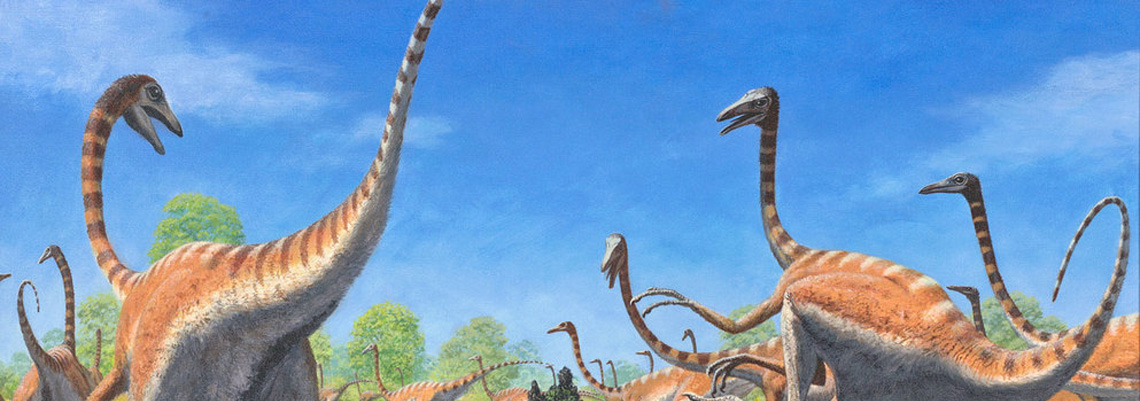
While going for a jog, I got thinking about how much trouble I’d be in if a dinosaur randomly popped out and started chasing me. Nearly every dinosaur was faster than the average human. Not good!
It got me thinking, though. If humans can’t outrun meat eating dinosaurs, what could? Which dinosaur actually was the fastest? After returning home (not eaten by a dinosaur, I might add), I did some research.
The fastest dinosaurs likely were the ornithomimids or “ostrich mimic” (think the gallimimus herd from Jurassic Park). They were ostrich like, bipedal (walked on two legs) dinosaurs that could potentially run upwards of 50 mph. The ornithomimids lived in the Cretaceous period along with the tyrannosaurus and triceratops.
While watching Jurassic Park growing up, I always wondered why the t-rex needed to surprise the gallimimus herd by storming out of the trees. Now it makes perfect sense, as the tyrannosaurus had no way of catching them in a predatory chase. Neat!
Why Two-Legged Dinosaurs Were the Fastest
It seems strange to think that bipedal dinosaurs were the fastest animals back in the prehistoric age considering quadrupedal (walk on four legs) mammals rule the modern day speed arena.
The reason bipedal dinosaurs dominated the speed race back then likely has to do with their comparatively slow quadrupedal counterparts.
There’s a running theory that most theropods (two-legged meat eating dinosaurs) were warm-blooded and most quadrupedal, herbivore dinosaurs were cold-blooded. The body configuration makes a big difference as warm-blooded creatures can sustain larger running speeds due to the increased metabolic energy available.
Cold-blooded creatures often move slower, lumbering around due to low metabolic energy.
Here’s a brief list of some popular bipedal dinosaurs and their known run speeds:
- Tyrannosaurus Rex – About 20 mph
- Velociraptor – About 25 mph (with 40 mph sprint)
- Dilophosaurus – About 20 mph
- Megalosaurus – About 30 mph
- Compsagnathus – About 40 mph
As a side note, one of the dinosaurs in the list above is actually the very first dinosaur discovered. I wrote an entire article about this underserved dinosaur. He needs some love! Check it out.
How We Know Dinosaur Speeds
Please be aware this section is a little technical sounding. Sorry! You’ve been warned.
While it’s not a perfect science, our modern knowledge of dinosaur speeds largely comes down to four things:
- Fossilized footprints
- Their own anatomy (morphology)
- Comparison with modern animals
- Laws of physics (biomechanics)
Fossilized Footprints
With fossilized footprints (or ichnofossils), paleontologists can determine a few different key factors about the given dinosaur. The best way fossils help us understand the movements of dinosaurs is by the use of trackways.
Trackways are basically sequences of fossilized steps made by a particular dinosaur. The better the trackway, the more accurate our estimation of their speed and movement style.
The best part about trackways is the fact they prove, without a doubt, the speed of the dinosaur involved. Whether the dinosaur was running or walking, however, is a different story.
Dinosaur Morphology
Footprints are very limited in teaching us dinosaur speeds, unfortunately. There’s just not enough of them!
A much better and more accessible way of learning how dinosaurs moved is through something called morphology (basically anatomy). By reviewing the skeletal structure and inferring the anatomy, paleontologists can learn quite a lot about the dinosaur.
This is how they knew dinosaurs walked upright with their legs underneath their bodies instead of to the side (like a reptile).
Modern Animal Comparison
One of the easiest ways paleontologists can look at dinosaur movement speeds is by looking at animals in existence today. Paleontologists can make some great guesses as to how some dinosaurs moved by comparing them to similarly sized modern animals.
For example, triceratops were considered to be similar size to modern day elephants. By examining how elephants move, we can extrapolate some similarities that we can transfer over to the triceratops.
Is it an exact science? No, but it helps us understand them better. I’d put my money on this method as being the most successful.
Laws of Physics
Paleontologists use the laws of physics, or in this case bio-mechanics, to help determine dinosaur movements. By recreating muscle patterns and taking gravity and other factors into account, paleontologists can get a better picture of how a dinosaur might have moved and how fast it was.
This process is quite tricky, though, as even trying to simulate modern animals is not easy. Adding in more than 65 million years of evolution and also no particular way of knowing exactly how much mass each dinosaur had makes this method not as effective as others.
If you’d like a more thorough overview of how we can determine dinosaur speeds, check out this article at the University of California Museum of Paleontology.
Technical section done. Good job!
Why Modern Mammals are Faster Than Dinosaurs
This section might be a bit of a trick question of sorts as the fastest mammals are only faster in their sprint, not their endurance.
With land animals like cheetahs and birds like peregrine falcons, modern mammals are indeed the fastest ever recorded. Their top speeds are small bursts that can only be maintained for a short period of time (with cheetahs needing to lie down and rest after sprinting).
Dinosaurs had the ability to maintain their top speeds a lot longer, as they had a special, extra air pocket system that delivered additional oxygen throughout their bodies.
But why are some modern mammals faster? That largely comes down to body size and evolutionary traits. Cheetahs have longer legs, proportionally, than any other feline species which allows them to run considerably faster. Ostrichs, the fastest bipedal animal today, runs nearly as fast as their prehistoric counterparts the ornithomimids due to their long legs as well.
Size also plays a factor here. Smaller animals usually have a higher metabolism, giving them the energy they need to hit their top speeds.
Fastest Four-Legged Dinosaurs
Four-Legged dinosaurs (or quadrupeds) had the largest disadvantage when it came to speed. Many quadrupedal dinosaurs were larger and could not move as quickly.
So what four-legged dinosaur was the fastest? The likely candidate for fastest four-legged dinosaurs would have to go to a moderately sized hadrosaur. A hadrosaur is mostly quadrupedal but can also walk on its hind legs like a theropod.
Here’s a brief list of some popular quadrupedal dinosaurs and their known run speeds:
- Stegosaurus – About 7 mph
- Triceratops – About 20 mph
- Brachiosaurus – About 10 mph
- Parasaurolophus – About 25 mph
Fastest Flying Dinosaurs
Pterosaurs are widely considered the best flyers back in the prehistoric. According to a 2010 study by PLOS ONE, the largest pterosaurs could reach speeds of almost 70 mph for several minutes and then settle into a nice gliding speed of about 55 mph.
So, why aren’t the pterosaurs considered the fastest dinosaurs of all time?
Put simply, they’re technically not dinosaurs.
Before you start throwing things at your screen for the misdirection, please re-read the previous sentence. Notice how I put in the word ‘technically’? That was an intentional choice.
Most people, myself included, consider pterosaurs, and other flying prehistoric reptiles, to be dinosaurs. I mean, come on, what kid didn’t grow up with a pterodactyl in their toy dinosaur collection?
But in my attempt to provide accurate, factual information regarding dinosaurs, I have to try and follow the proper distinctions. Such is my life as a dinosaur fanatic.
You’re probably wondering why pterosaurs aren’t classified as dinosaurs. Turns out they’re sort of like cousins.
Check out the diagram below:

If you go from bottom to top, you can see they all start at archosaur and branch off from there. Pterosaurs are on their own line away from dinosaurs, showing that they came from the same ancestor, but are not classified in the same category.
There are actual flying dinosaurs, however. They had feathers and were much more like modern day birds. In fact, some modern birds evolved from these dinosaurs. If you’re interested, check out a cool post I wrote about some feathered, flying dinosaurs. You’ll be surprised as to why dinosaurs had feathers!
So, the fastest flying dinosaur award goes to: archaeopteryx. Really not the answer I expected either, but the truth is the truth!
Fastest Aquatic Dinosaurs
Just like with the flying dinosaurs, there’s a bit of a conceit that I have to admit to here. There’s technically only one known dinosaur that could actively swim and that was the spinosaurus. It basically wins here by default. The rest of the aquatic prehistoric monsters fall under the reptile category.
The spinosaurus is actually a lot cooler than most people think. I know, it wrecked our childhoods in Jurassic Park III, but give it a chance.
The spinosaurus was considered the biggest meat eating dinosaur of all time. It had a large fin on its back, webbed feet and a special hole on the back of its head to improve its swimming capability.
The only other dinosaur that might have spent any other time in the water is the ceratosaurus. Studies suggest it might have done some aquatic hunting, but would not have lived in the water like the spinosaurus.
Fastest swimming dinosaur award goes to: spinosaurus.
Related Questions
Did four-legged dinosaurs gallop? Yes! Dinosaurs like triceratops could gallop given the right situation. It likely wouldn’t have been as smooth as modern day horses, but would still be considered a gallop. The closest modern day equivalent is the rhinoceros, which is fully capable of galloping.
Is the velociraptor the fastest dinosaur? While likely being fast in short bursts (upwards of 40 mph), velociraptors were not the fastest dinosaur. They have been clocked at about 25 mph, much slower than they are often portrayed in mainstream media.
Conclusion
While I wouldn’t feel safe being chased by any dinosaur, it’s interesting to think about how fast some of them actually were.
Cheetahs, still, are the reigning kings of land speed, but some dinosaurs could really motor as well. What’s most surprising is how fast some of the two-legged dinosaurs could run. It’s largely contradictory to today’s mammals where the fastest run on four legs instead of two.
I guess when it comes to speed in the prehistoric world, having more legs isn’t always better.
Recent Posts
Sharks are older than dinosaurs. They've stood the test of time and are almost exactly the same as they were all those millions of years ago. It begs the question: why haven't sharks evolved? Sharks...
Most species on the planet sleep at night. There are, however, the odd nocturnal animals around - or people who work night shifts - that sleep during the day. It makes you wonder, though: did...
